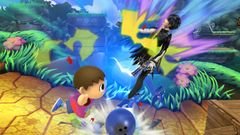Flinch
- Not to be confused with hitstun.

Flinching is an animation used by every character when their current action is interrupted by an attack. The interrupted action is replaced with an animation of being hit, with the character reacting differently to the attack depending on its knockback strength and which part of their body is hit (for example, rearing their head back if hit high, or kneeling if hit low). The length of the flinch animation is correlated to the attack's hitstun, which itself is directly determined by knockback; as a result, stronger attacks cause longer and more exaggerated flinch animations, while attacks that do not deal any knockback will not cause flinching. If an attack deals high enough knockback, characters are sent into tumbling after their flinching animation. However, windboxes are able to deal flinchless knockback to fighters, manifested by simply pushing them around.
As flinching is directly related to knockback received, reducing knockback through a sticker or Equipment, increasing weight through a Super Mushroom or Metal Box, or using a move with armor, will also make it more difficult (or impossible) to flinch. Metal Mario and Giga Bowser (in Super Smash Bros. Melee only) are a few examples of characters who don't flinch when hit with low knockback attacks, due to a combination of their weight, along with the inclusion of armor or knockback taken multipliers. Bowser in Super Smash Bros. 4 onward, as well as Kazuya in Super Smash Bros. Ultimate, have fighter abilities that prevent them from flinching when hit by attacks that deal below a certain amount of knockback.
Flinching while charging an attack or special move will cause the charge to be lost, regardless of whether any charge had been saved previously. Mewtwo does not lose its projectile's charge if it flinches, though this is only the case for when it is about to fire the projectile, not while it is actually charging.
Flinching does not strictly apply to playable characters. Phosphora can flinch in Smash 4 when attacked, as can most Assist Trophies in Ultimate. Petey Piranha, a boss in Super Smash Bros. Brawl, may also flinch when attacked.
Flinching animations[edit]
In all Super Smash Bros. games, every character has multiple flinching animations. On the ground, they are split into three height categories — high, central, and low — depending on the specific hurtbox struck, and three intensities — weak, medium, and strong — depending on the attack's knockback, leading to nine possible flinching animations. Internally, these are first referred to by height, then by strength; for example, DamageHi1, DamageN2, and DamageLw3 refer to the characters' high weak, medium central, and low strong flinching animations. Medium flinch animations require the character to take at least 12 frames of hitstun (15 frames in Ultimate), equivalent to at least 30 units of knockback (37.5 units in Ultimate), while heavy flinch animations require them to take at least 21 frames of hitstun (equivalent to at least 52.5 units of knockback). If hit in the air or off the ground, characters initially only have three flinching animations depending on knockback strength (known internally as DamageAir1, DamageAir2, and DamageAir3), with height not being a factor.
If a character takes enough knockback to be sent tumbling (equivalent to at least 80 units of knockback, or 32 frames of hitstun), several other flinching animations are used. If the attack launches at an angle between 70° and 110° (ignoring directional influence), a homogeneous "high launch" animation is used (known internally as DamageFlyTop); otherwise, up to three launch animations are used depending on height (known internally as DamageFlyHi, DamageFlyN, and DamageFlyLw). In Ultimate, the high launch animation modifies characters' falling speed and gravity during knockback, homogenizing the effect of vertical launch speed on them; in other games, it has no practical difference other than their hurtboxes being shifted differently. Additionally, if the character has accumulated at least 100% damage and is not sent into the high launch animation, they have a 30% chance of using a reeling animation instead (known internally as DamageFlyRoll).
Later Smash games add a few more flinching animations. From Brawl onward, characters hit by electric or paralyzing attacks undergo a more realistic electrocution animation (known internally as DamageElec) during hitlag or paralysis, respectively. In Smash 4 and Ultimate, hitting a character from behind with Shulk's Back Slash causes them to use a single launch animation where they remain facing away, which is the same as the animation when bouncing off walls (known internally as WallDamage). In Ultimate, this is used when a character is hit from behind by any attack that deals tumbling-level knockback, preventing them from turning around like in previous games; for lower knockback strengths, the standard flinching animations are used depending on the circumstance, except the character doesn't turn around until near the end of the animation. Additionally, Ultimate introduces a unique flinching animation for characters launched by a meteor smash when their damage is 100% or more (known internally as DamageFlyMeteor), which overrides the normal launch animations outside of reeling.
To summarize, there are a total of 17 possible flinching animations in Smash 64 and Melee, 18 in Brawl, 19 in Smash 4, and 20 in Ultimate.